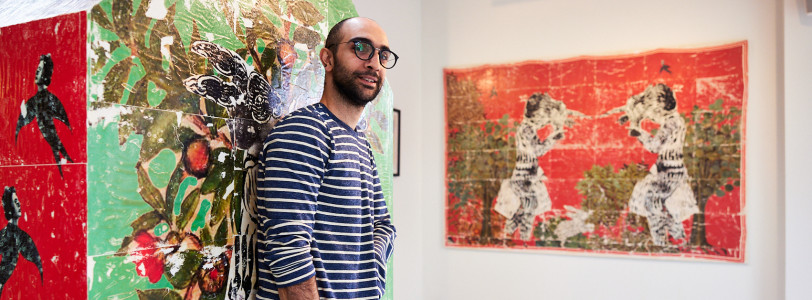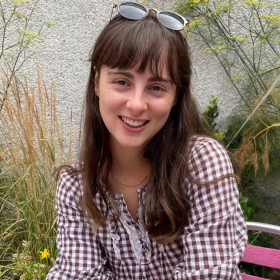Can you please introduce yourself to the reader and explain what Studio of Sanctuary aims to do?
Hi, I’m Damon Jackson-Waldock, I am the Programme Director at The Art House. The Art House supports artists through residencies or planning and curating exhibitions in the galleries. We have two gallery spaces here and tend to programme around 10-15 exhibitions a year, and the same amount of artist residencies.
What is the Studio of Sanctuary and where did it start?
The Art House became a Studio of Sanctuary in 2017. It was the first one of its kind. We were given a national award from the City of Sanctuary to recognise the work we were doing supporting people in the asylum process or refugees. There are now other studios of sanctuaries in the UK. We were awarded the status because of how we embedded it into our everyday practice. We didn’t do it for the status, we did it because it mattered, and then the status followed.
We discovered that there were a lot of people being signposted to us at The Art House from a place called Urban House, an initial accommodation centre very close to us in the city centre of Wakefield. The team began to discover that there were a lot of creatives based in Wakefield in the asylum process. It grew organically from other projects, thinking about how we could support artists with free studio space here. We have around 45 studio spaces on site and began giving bursaries to people in the asylum process. We wanted to help them develop and rebuild professional portfolios. We felt that if artists were creatively supported throughout their asylum seeking process, and if they were successful in seeking asylum, they would be more likely to make valuable contributions to the creative arts in the UK. We want to be a welcome safe space for everyone. We’ve always had inclusion and breaking barriers and representing marginalised artists at the centre of our work.
Last summer, we were awarded a Gallery of Sanctuary status. That has organically grown from the studio because we are working with artists with lived experience of displacement or seeking asylum. One of the things we think is really powerful here is that there is no one artistic or community programme. When we have artist residencies, there is a lovely meeting of minds between different groups. So that means artists who don’t have lived experiences are working with and doing valuable projects with those who do.

How have you found the balance between pastoral support and professional development?
The Studio of Sanctuary is not a programme, it’s a way of life. You never know what’s going to happen on a daily basis. You’re working with people from complicated contexts and often dealing with a lot of trauma. There are a lot of things that come up and pastoral care is needed, so it’s been a journey. You have to respond to people and our staff have been there through ups and downs. We have supported asylum seekers with the legal process, as well as with their creative development. Our CEO spent a month in London campaigning at a deportation centre.
We’re not only offering creative support, we offer a warm welcome to anyone who comes through our doors. I would say it’s the hardest work that we do here, because of the pastoral side. But it's some of the most important work too, and has so many special moments.
How have you experienced the power of art and culture to create community in this setting?
One side of our work is professional development for artists and the other side is based on facilitating community through art workshops. That part has grown a lot in recent years and now people come in regularly to draw, embroidery or gardening. This has a way of pulling people together, alongside tea and cake. It’s powerful in facilitating stepping out of the stress of their everyday lives.
It’s a simple idea but it’s powerful when everyone is sitting around a table. I’ve seen the power of art to cross boundaries. For example, despite not speaking the same language, I’ve seen people share different ways of crocheting and how that creates relationships. Everyone who works here comes from a creative background. I think we all understand that art and creativity can play a huge role in transcending language and culture and skin colour.
It can be easy to stigmatise people. But when you sit around a table and create, you start to realise that we have a shared humanity. That’s what it can offer. For that moment, working together, everyone has a shared sense of just being a person in the world. There’s no labels at that point.
In Wakefield we have a majority white population and there has unfortunately been a rise in anti-immigration sentiment. I think it’s important to do things that help community cohesion. Our work is open to everyone. We don’t just work with asylum seekers, although they are valuable participants, but our work is open to all groups. We are able to sit down and experience shared humanity.

How do you make the Studio of Sanctuary a safe space?
The Studio of Sanctuary exists not only to support artists when they are in our building, but also when they move away. There is no real end point to being involved, so I’m still supporting some artists we worked with in 2017 through applications and exhibitions, even if they’re not based here anymore. We’ve had one artist move on and set up a tailoring business in Wakefield. We do that with any artist, not just asylum seekers.
The Studio of Sanctuary has a huge community side to it now. We have a close working relationship with those who run the initial accommodation centres across Wakefield. We have a staff member working specifically on the Studio of Sanctuary who has worked with the national City of Sanctuary and she is very experienced with the logistics and legal side of the asylum seeking process.
Over time, people will start to feel safe and welcomed here. It’s difficult to have consistency because people are often relocated. But we try to offer consistency within that changing process. People start to become very familiar with what we can help with and what we offer. It has grown organically over time.
More broadly, The Art House was intentionally built to be an extremely physically accessible space. That ethos has impacted how we approach all aspects of accessibility.
How can people contribute to this work and model it in their own lives?
There is a lot going on in the world. Going on this journey with people who have been displaced or are seeking asylum is hugely important. Don’t do it quickly. You have to live and breathe it. It’s okay to not do it, if you don't have the capacity. If you do, make space and prepare for what you’re getting into. It can be some of the most challenging work anyone could be doing, but it’s also some of the most rewarding.









0 Comments